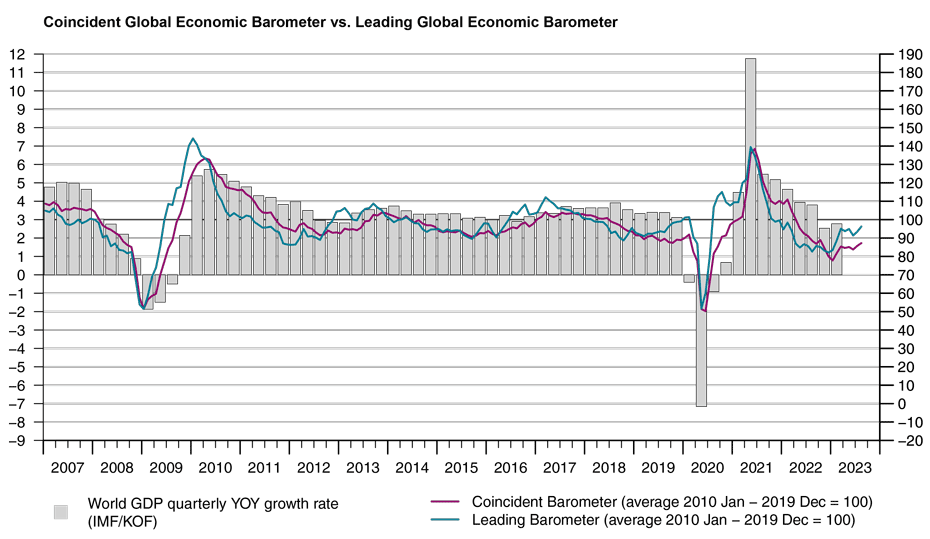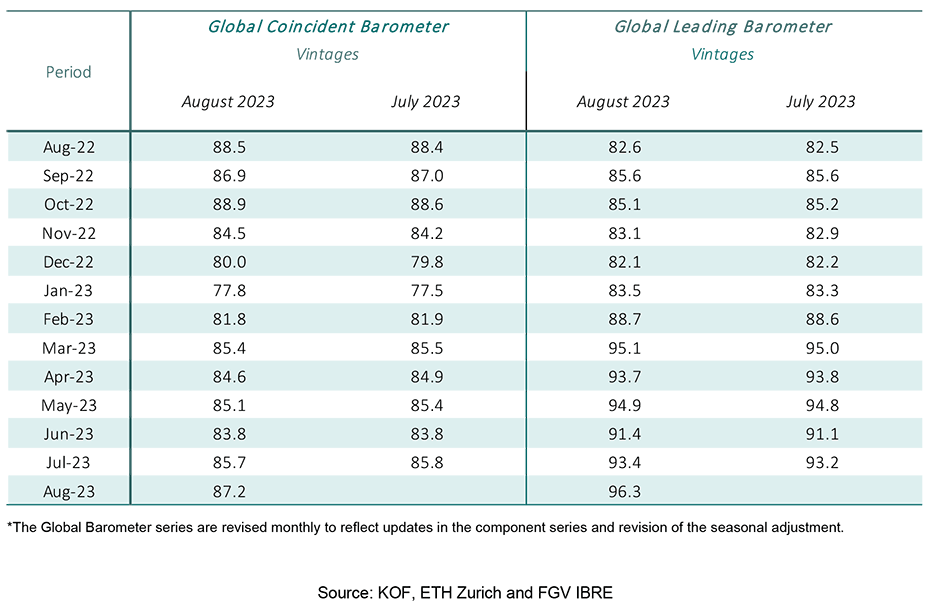Leading Global Barometer rising towards historical average
In August, the Global Barometers increase for the second month in a row across the regions. The Coincident Barometer continues to slowly improve in 2023 while the Leading Barometer advances more rapidly, approaching almost the neutral level of 100 points.

The Coincident Global Economic Barometer increases by 1.5 points to 87.2 points in August 2023. The Leading Barometer rises 2.9 points to 96.3 points, its highest level since February 2022. The distance between the indicators increased to 9.1 points, the largest difference since May this year. The results were driven by advances in all three regions analysed.
“The outlook for the global economy is gradually improving, or rather normalising. For some time now, the leading indicator has been less pessimistic than the coincident indicator. In the past, the latter was a clear signal of a turnaround. With inflation still high, albeit declining, and interest rates still rising, albeit at a much slower pace, and likely to have peaked soon, we have probably passed the cyclical trough. However, many of the structural problems facing the global economy do not appear to be going away any time soon. In that sense, the challenges ahead remain”, evaluates Jan-Egbert Sturm, Co-Director of KOF Swiss Economic Institute.
“Many of the structural problems facing the global economy do not appear to be going away anytime soon. In that sense, the challenges ahead remain.”Jan-Egbert Sturm
Coincident Barometer – regions and sectors
In August, the largest contribution to the increase in the Coincident Barometer came from the Asia, Pacific & Africa region with 0.8 points, followed by Europe and the Western Hemisphere with 0.5 and 0.2 points, respectively. The Western Hemisphere records its fourth consecutive increase, accumulating 8.1 points. After remaining stable at a low level, the coincident Barometer is slowly showing small signs of improvement. In line with the tightening of monetary policy in various countries to combat inflation, these signals are still weak. The graph below shows the contribution of each region to the deviation of the Coincident Barometer from the historical mean of 100 points.
The Coincident sector indicators present diverse results this month. The indicators for the Economy (aggregated business and consumer evaluations), Trade, and Construction rise, while the indicator for Services falls slightly and Industry remains constant.
Leading Barometer – regions and sectors
The Leading Global Barometer leads the world economic growth rate cycle by three to six months on average. In August, the Asia, Pacific & Africa region contributes 1.2 points, followed by Europe and the Western Hemisphere with 1.0 and 0.7 points, respectively. In general, the level of the indicators suggests moderately skeptical expectations for world economic activity, with gradual improvement in the past two months.
The Leading indicator sectors for Services, Industry, and the Economy (aggregated business and consumer evaluations) increase in August, while the indicators for Construction and Trade decrease this month. With this result, Services returns to a level above 100 points, reaching its highest level since February 2022 (105.0 points).
The Global Economic Barometers
The Global Economic Barometers are a system of indicators enabling timely analysis of global economic development. They represent a collaboration between the KOF Swiss Economic Institute of the ETH Zurich in Switzerland and Fundação Getulio Vargas (FGV), based in Rio de Janeiro, Brazil. The system consists of two composite indicators, the Coincident Barometer and the Leading Barometer. The Coincident Barometer reflects the current state of economic activity, while the Leading Barometer provides a cyclical signal roughly six months ahead of current economic developments.
The two Barometers comprise the results of economic tendency surveys conducted in more than 50 countries with the aim of achieving the broadest possible global coverage. The advantages of economic tendency surveys are that their results are usually readily available and are not substantially revised after first publication.
The Coincident Barometer includes more than 1,000 different time series, while the Leading Barometer consists of over 600 time series. Cross-correlation analysis is used to decide which individual time series are included in the barometers. This involves correlating the individual time series with a reference series. The reference series used is the year-on-year growth rate of global gross domestic product (GDP), where the individual national GDPs are aggregated at purchasing power parity to form global GDP. A time series is only included in a Barometer if it shows a sufficiently high correlation and a suitable synchronization or lead with the reference series. The time period used for this correlation analysis currently runs from January 2010 to December 2019.
The series of the two Barometers are revised each month at publication and are standardized to have a mean of 100 and a standard deviation of 10 for the 10-year period previous to the most recent observations.
The methodology is described in:
Klaus Abberger, Michael Graff, Aloisio Jr. Campelo, Anna Carolina Lemos Gouveia, Oliver Müller and Jan-Egbert Sturm (2020), The Global Economic Barometers: Composite indicators for the world economy. KOF Working Papers, vol. 471, Zurich: KOF Swiss Economic Institute, ETH Zurich, 2020.
Contact
KOF Konjunkturforschungsstelle
Leonhardstrasse 21
8092
Zürich
Switzerland


